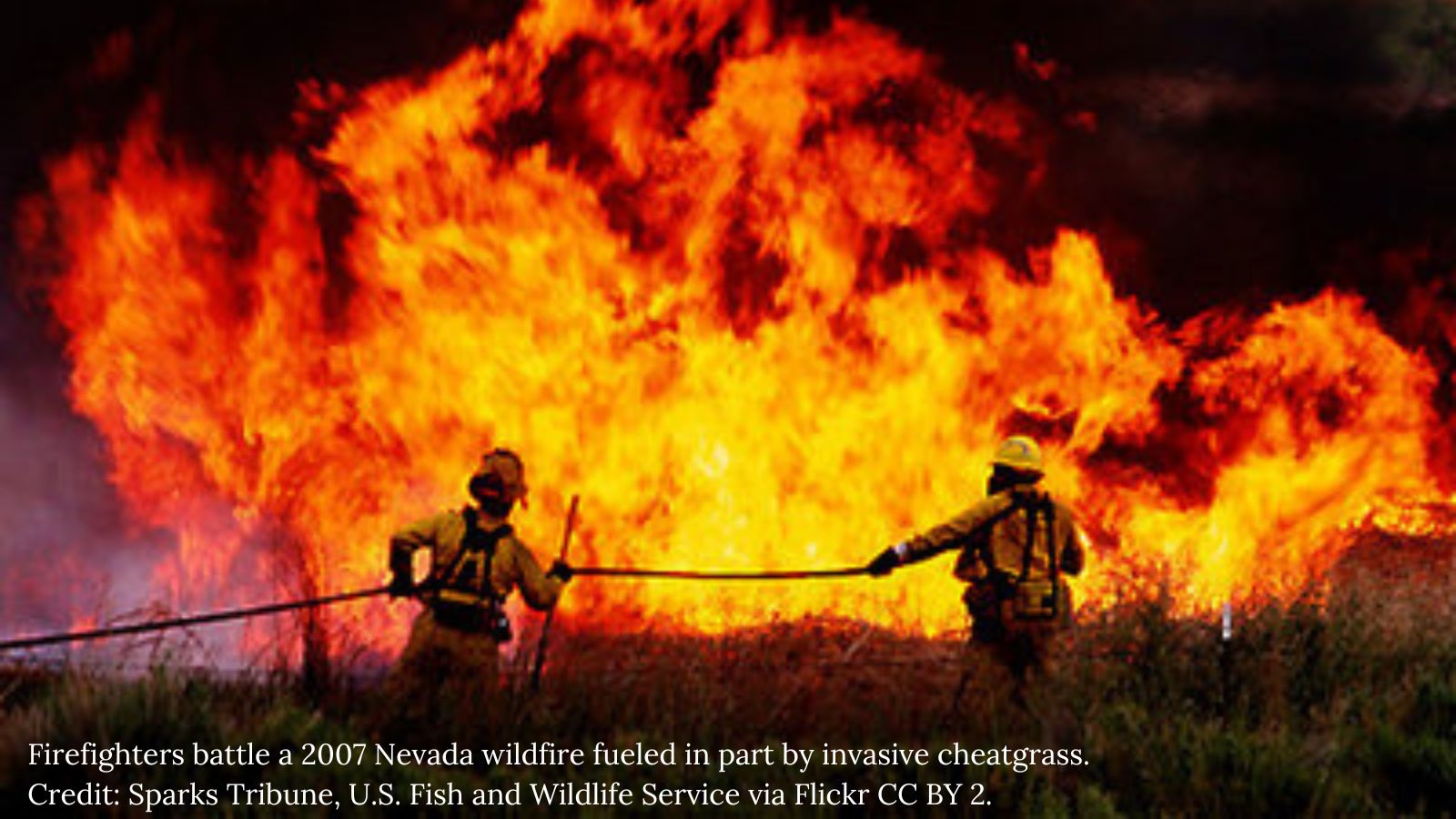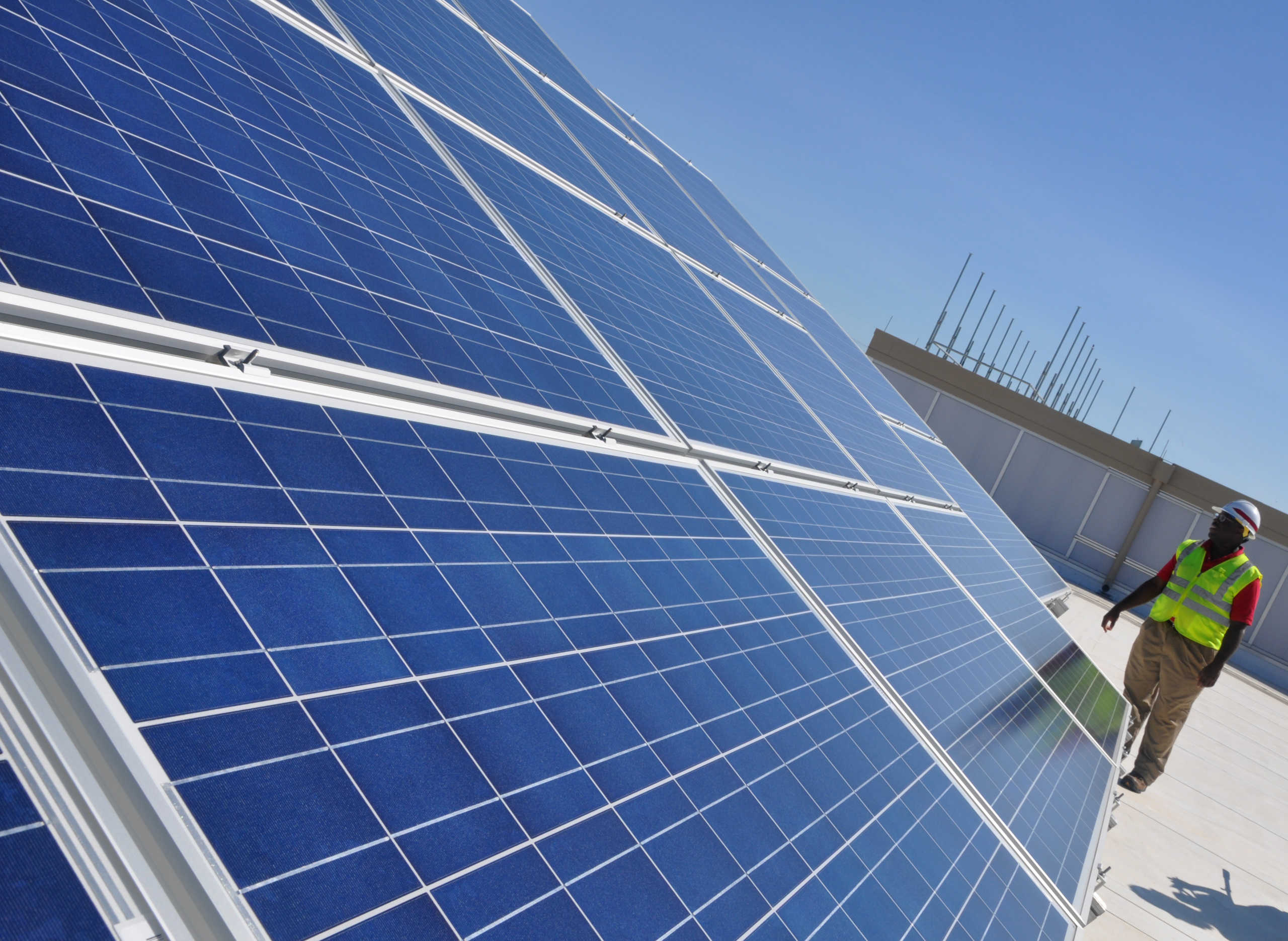
Wildfires and climate change
Climate solutions that can help solve global warming and address our wildfire crisis

Cover photo: Firefighters battle a 2007 Nevada wildfire fueled in part by invasive cheatgrass. Credit: Sparks Tribune, U.S. Fish and Wildlife Service via Flickr CC BY 2.0
Climate change is making wildfires worse. Worsening drought and hotter temperatures affect how long, how hot and how dry fire seasons are. Wildfires, in turn, release more climate changing carbon emissions that are driving climate change. This destructive cycle feeds on itself as fires rage through our forests and grasslands, putting our communities at risk.
Greater intensity is the hallmark of the new breed of wildfires. The number of annual large fires in the West has tripled. Five of California’s 10 largest wildfires on record happened in 2020, as the state set a new record for acres burned. In many parts of the country, wildfire season is now virtually year round. Colorado’s worst fire ever, the Marshall Fire, erupted in Boulder County last Dec. 30.
Until we adopt robust policies to reduce emissions and address global warming, climate change will keep exacerbating our wildfire problem.
Here’s what we can do:
Protect old growth and mature forests and trees
This is the climate solution you don’t have to invent. Our old growth forests are critical tools in the fight against climate change, because the bigger a tree, the more carbon it takes out of the air. Trees absorb carbon at a high rate for years, with incremental increases as time passes. Even the soil in old-growth forests can store carbon. For example, the Tongass National Forest in Alaska sequesters 44% of total carbon stored across the entire National Forest System—that’s 8% of the carbon stored in all U.S. forests.
On Earth Day this year, the Biden administration issued an Executive Order that directs federal agencies to conduct an inventory of mature and old-growth forests on America’s federal lands, to help determine what policies the United States should adopt to protect them. Now, we need those agencies to swiftly move to create and implement robust policies that achieve those goals.
Zero out transportation emissions
Transportation is now America’s number one source of global warming pollution, with greenhouse emissions from cars, trucks, buses and other vehicles surpassing every other source. We simply can’t solve global warming without changing how Americans get around.
Cars account for 60 percent of our transportation pollution. While Americans — and even automakers — realize the days of gas-powered vehicles dominating our roads are coming to an end, the transition needs to speed up. For example, some 450,000 dirty diesel school buses are still in service today. While school districts await new fleets of electric buses, the old ones are adding to our carbon emissions while putting tens of millions of children at risk of cancer and respiratory diseases.
To goose the process, the Biden administration has set an ambitious, yet achievable, goal of a zero-carbon transportation system by 2050. That would require every car on the road to run on clean, renewable energy by then. And if we make it easier, more affordable, and more pleasant to take a train or bus, to share rides, or to bike or walk, then more of us will choose to travel without a car or even not own a car at all.
To move us closer to a zero carbon transportation network, we are working to:
-
Ensure all new cars cars sold after 2035 are electric;
-
Electrify all school and transit buses by 2030;
-
Double the number of people who walk, bike or take public transportation by 2030.
Clean up polluting power plants
More than 3,400 fossil fuel-fired power plants still operate in the United States today, making electricity production the second-largest source of global warming pollution. It is going to take action at all levels of government to get power plant pollution under control. To remedy the situation as quickly as scientists say is necessary to maintain a livable planet, we need to both put strong limits on existing fossil fuel-fired plants and accelerate the transition to renewable energy. Here are some specific actions we can take:
-
The U.S. Environmental Protection Agency should enact the strongest possible limits on carbon dioxide pollution from new and existing power plants.
-
Congress should pass a climate package that includes extending and expanding clean energy tax credits
-
States, cities, and counties should commit to generating 100% of their energy from renewable sources.
Electrify our homes and buildings
To prevent air and water pollution and avoid the worst impacts of global warming, America must move toward meeting our energy needs with 100% renewable energy. Getting there will require that we get the most out of every bit of energy we use – and that we stop burning fossil fuels in our homes and commercial buildings.
Wind and solar power are rapidly replacing dirty fossil fuels such as coal as leading sources of our electricity. As our electricity grid becomes cleaner, replacing the direct burning of gas, heating oil and propane in our buildings with electricity will reduce pollution of our air, land and water, as we produce and use less fossil fuel.
New and improved technologies are putting clean, efficient electric space heating and water heating — and electric appliances such as stoves — within the reach of most American households. Analysis shows that electrifying the vast majority of America’s residences and commercial spaces by 2050 could reduce net greenhouse gas emissions from the residential and commercial sectors by about 306 million metric tons of carbon dioxide (CO2) in 2050. That is the equivalent of taking about 65 million of today’s cars off the road – almost three times the number of vehicles in Texas.
Policy makers at the local, state and federal levels should implement plans to accelerate the transition from fossil fuels to clean electricity in our buildings. They should:
-
Require all-electric systems in new construction.
-
Implement rebate programs, incentives and low-cost financing.
-
Implement regulatory solutions, including rate design and fuel-switching regulation changes.
-
Create and expand tax incentives for electrified buildings.
-
Update appliance efficiency standards.
End fossil fuel subsidies
Every year, the United States government gives away $20 billion to the fossil fuel industry in the forms of tax breaks, incentives and other subsidies; ironically, for an industry that made $28 billion in profits in 2018 alone. This colossal waste of taxpayer money could be better spent on pressing priorities that help all Americans, not just those with stock in fossil fuel companies.
And it’s not just a waste of money. Often, our tax dollars are being used to start up, or extend, the life of fossil fuel projects that wouldn’t be profitable without assistance. We need more wind turbines, solar panels and electric vehicles — not more fossil fuel infrastructure. By ending subsidies that give fossil fuels an unwarranted advantage, we’ll free up more money to invest in renewable energy technology and the market will more quickly move toward renewable energy.
Wildfires are getting worse. But if we take the actions delineated above, in a timely fashion, we can figuratively shift the winds and literally squelch some of the flames.
This blog was coauthored by Matt Casale, PIRG Director of Environment Campaigns
Topics
Authors
Ellen Montgomery
Director, Public Lands Campaign, Environment America
Ellen runs campaigns to protect America's beautiful places, from local beachfronts to remote mountain peaks. Prior to her current role, Ellen worked as the organizing director for Environment America’s Climate Defenders campaign. Ellen lives in Denver, where she likes to hike in Colorado's mountains.
Find Out More

Bank of America said it would stop financing drilling in the Arctic Refuge. Now it’s backtracking.

Unlocking America’s rooftop solar potential

We brought FedEx’s golden solar opportunity to their doorstep

